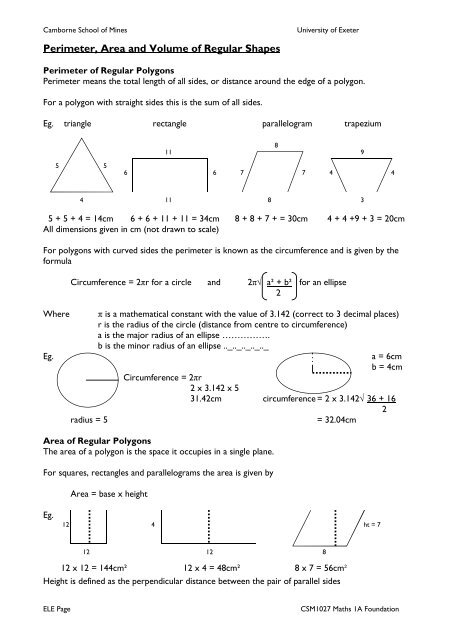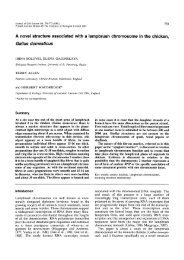Perimeter, Area and Volume of Regular Shapes - University of Exeter
Perimeter, Area and Volume of Regular Shapes - University of Exeter
Perimeter, Area and Volume of Regular Shapes - University of Exeter
Create successful ePaper yourself
Turn your PDF publications into a flip-book with our unique Google optimized e-Paper software.
Camborne School <strong>of</strong> Mines<strong>University</strong> <strong>of</strong> <strong>Exeter</strong>The volume <strong>of</strong> certain non-prismatic shapes can be determined by using the correct formula.SphererPyramid <strong>and</strong> conevolume <strong>of</strong> a sphere = 4 π r 33eg. determine the volume <strong>of</strong> a spherical component with the radius<strong>of</strong> 7cm.volume = 4 x 3.142 x 7³ = 1436.76cm³3h1hrbvolume = 1 x base area x height3Pyramidvolume = 1 x 1 x b x h3Conevolume = 1 x π r² x h3eg. calculate the volume <strong>of</strong> a cone with base radius <strong>of</strong> 6cm <strong>and</strong> perpendicular height <strong>of</strong> 10cm<strong>Volume</strong> = 1 x 3.142 x 6² x 10 = 376.00cm³3<strong>Volume</strong>s <strong>of</strong> irregular shapes can be determined by calculation if the mass <strong>and</strong> density <strong>of</strong> thematerial from which it is known or by displacement.Calculation <strong>of</strong> volume using density <strong>and</strong> mass.eg. density <strong>of</strong> substance from which an irregular object is made is 8500kg/m³. if it has a mass <strong>of</strong>425kg, calculate its volume.<strong>Volume</strong> = mass = 425 = 0.05m³density 8500Measurement <strong>of</strong> volume using displacement500cc2nd reading300cc 1st reading volume = 2nd reading – 1st reading= 500 – 300 = 200ccMeasuring cylinderELE PageCSM1027 Maths 1A Foundation
Camborne School <strong>of</strong> Mines<strong>University</strong> <strong>of</strong> <strong>Exeter</strong><strong>Perimeter</strong>, <strong>Area</strong> <strong>and</strong> <strong>Volume</strong> <strong>of</strong> <strong>Regular</strong> <strong>Shapes</strong> Worksheet 1Calculate the area <strong>of</strong> the following shapes1. 2. 3.5 cm15 cm9.5 cm15 cm4.1.3 cm3 cm5.3.5 cm12 cm12 cm7.8 cm4.5 cm1.3 cm47.5 cm6 cm2.5cm24 cm5 cm6. A water tank is a cuboid with a base <strong>of</strong> 1.2m by 0.8m. How deep is the water when thetank contains 0.384m³ <strong>of</strong> water?7. A classroom is 5m x 6m x 3m. Health regulations require that each student must have aminimum <strong>of</strong> 5m³ <strong>of</strong> air. How many students can occupy the room?Calculate the volume <strong>of</strong> the following shapes. All dimensions in cm.8. 9. 210.Internal r = 0.75External r = 1.00221281526ELE PageCSM1027 Maths 1A Foundation
Camborne School <strong>of</strong> Mines<strong>University</strong> <strong>of</strong> <strong>Exeter</strong><strong>Perimeter</strong>, <strong>Area</strong> <strong>and</strong> <strong>Volume</strong> <strong>of</strong> <strong>Regular</strong> <strong>Shapes</strong> Worksheet 2Calculate the shaded area <strong>of</strong> the following shapes1. 2. 3.5 cm 3 cm6 cm9 cm12 cm2.5 cm2 cm4. 5.12 cm15 cmall circles have a radius <strong>of</strong> 1.5cm4 cm2 cm3.5 cm6 cm 16 cm12 cm12 cm9 cm3 cm32 cmradius <strong>of</strong> circle = 3cm6. An ingot 80 x 10 x 300mm is cast into a cylinder 120mm diameter. Calculate its length.7. A rivet has a hemispherical head 6mm radius <strong>and</strong> a stem <strong>of</strong> 6mm diameter <strong>and</strong> 15mmlength. Calculate the volume <strong>of</strong> 100 <strong>of</strong> the rivets.8. What would be the volume <strong>of</strong> (a) air (b) plastic in a ball with 25cm diameter made fromplastic 2mm thick?Calculate the volume <strong>of</strong> the following shapes. All dimensions in cm.79. 10.5Normal ht = 614Cylinderradius = 1.555ELE PageCSM1027 Maths 1A Foundation
















